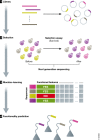High-throughput discovery of functional disordered regions
- PMID: 29789308
- PMCID: PMC5974509
- DOI: 10.15252/msb.20188377
High-throughput discovery of functional disordered regions
Abstract
Partially or fully intrinsically disordered proteins are widespread in eukaryotic proteomes and play important biological functions. With the recognition that well defined protein structure is not a fundamental requirement for function come novel challenges, such as assigning function to disordered regions. In their recent work, Babu and colleagues (Ravarani et al, 2018) took on this challenge by developing
Figures

Comment on
-
High-throughput discovery of functional disordered regions: investigation of transactivation domains.Mol Syst Biol. 2018 May 14;14(5):e8190. doi: 10.15252/msb.20188190. Mol Syst Biol. 2018. PMID: 29759983 Free PMC article.
References
-
- Davey NE, Seo MH, Yadav VK, Jeon J, Nim S, Krystkowiak I, Blikstad C, Dong D, Markova N, Kim PM, Ivarsson Y (2017) Discovery of short linear motif‐mediated interactions through phage display of intrinsically disordered regions of the human proteome. FEBS J 284: 485–498 - PubMed
-
- Erkine AM, Gross DS (2003) Dynamic chromatin alterations triggered by natural and synthetic activation domains. J Biol Chem 278: 7755–7764 - PubMed
-
- Luck K, Travé G (2011) Phage display can select over‐hydrophobic sequences that may impair prediction of natural domain–peptide interactions. Bioinformatics 27: 899–902 - PubMed
-
- Ma J, Ptashne M (1987) A new class of yeast transcriptional activators. Cell 51: 113–119 - PubMed
-
- Ptashne M, Gann A (1997) Transcriptional activation by recruitment. Nature 386: 569–577 - PubMed
Publication types
MeSH terms
Substances
LinkOut - more resources
Full Text Sources
Other Literature Sources

